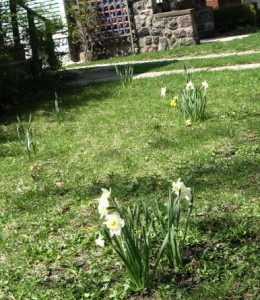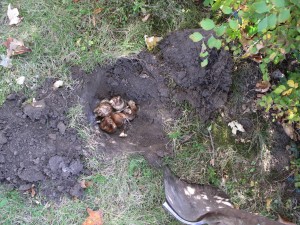Are you:
• running low on gardening space?
• looking for an excuse to postpone the initial mow in the spring?
• in need of a pick-me-up in the gray days of April?
Naturalizing daffodils in the lawn can be a unique solution to a variety of gardening situations. “Naturalizing” refers to establishing bulbs in places where they do not grow natively and where they successfully maintain themselves in competition with other plants, in our case, with our front lawn. We have also gone for a “natural appearance,” with drifts of plants dotting the yard, rather than straight lines.
Most of our garden beds are devoted for growing edibles rather than flowers. A couple years ago, we decided to try planting two dozen bulbs in our yard, and we’ve enjoyed their cheery early arrival in spring. The daffodils give our front yard the feeling of a field or a woodland, albeit on a small scale. This year, we decided to increase the daffodil presence with an addition of 100 more daffodil bulbs.
To plant the bulbs in bunches or drifts, I used a spade to cut threes side of a square into the grass and folded back the top. Bulbs should be planted 6 – 8 inches deep so I had to remove a bit more dirt in the bottom of the holes. I added a tablespoon of bone meal to each hole and settled 5 or 6 bulbs with roots pointing down. Then I covered the bulbs with the loose dirt and folded the top back over. A couple of steps on top of each hole closes the dirt and levels the grass.
Granted, naturalizing bulbs is not for everyone. People who like the suburban standard of a neatly manicured lawn will likely find that the chaos of bulbs popping up randomly clashes with their style. Those who use commercial or home applications of chemicals may experience little or no success with bulbs, depending on the formulas being applied. Our approach to lawn care is as organic as our gardening; we don’t add any chemicals so we don’t worry about that. We also have some grand old trees along our street, resulting in our front yard being partly shady, so the lawn does not grow vigorously in early spring. The foliage of the bulbs must be left alone and un-mowed until it dies down so that it can continue to feed the bulb even after the flowers have faded. We also don’t mind postponing our initial spring trim a bit and even mowing around the foliage for a time or two if necessary. Our lawn is on the smallish side, however.
There’s still time to plant bulbs in garden beds or even scattered among the grass. One suggestion I read was to plant stands or drifts of bulbs in the spots in the yard where the earliest melting occurs in the spring since those places get the most sun and warmth. A few bulbs could be planted in spots places now. One could also make a point of being more mindful in the spring and making a point to study the ‘hot spots’ in the yard when the great thaw arrives, with the intention of planting bulbs in the future. Planting bulbs is a nice surprise to give yourself: just when it seems spring will never come, early flowering bulbs provide some hope and cheer.






Have you checked out the daffodil line at the Arb in April? It’s pretty cool.